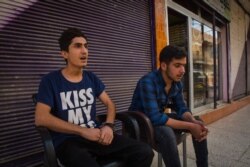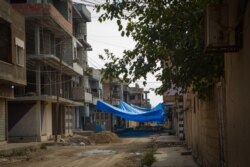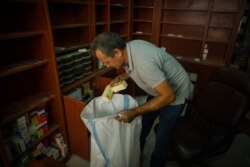Cities and towns along the border in northeastern Syria evacuated in the final hours of their cease-fire with Turkey on Tuesday.
In the nearly-abandoned border city of Darbasiyah, some of the few locals remaining were nervous and angry, saying they hoped the army of President Bashar al-Assad, backed by Russia, comes to town before Turkey starts bombing.
“No agreement was reached and people are afraid,” said Mohammed, a 39-year-old father of three. While most shops were closed, he was keeping his vegetable shop open, saying the people remaining need to eat. “We are afraid that what happened in Ras al Ayn will happen here.”
After a week of airstrikes and gunfire, Kurdish-led Syrian Democratic Forces pulled out of Ras al-Ayn on Sunday, leaving the city controlled by Turkish-backed fighters.
In Darbasiayah, families packed the blankets and appliances on trucks, and some of the remaining shopkeepers wrapped up their goods.
“This is our gift for defeating Islamic State militants?” said Adnan Mala Ali, a pharmacist with three small children, as he packed his medicines in a pickup truck. The Kurdish-led SDF was the U.S.’s strongest ally fighting Islamic State militants, and 11,000 fighters died in the battles.
Bewilderment
More than a month ago, the U.S. convinced its Kurdish allies to dismantle their enforcements and remove their weapons from large swaths of the border, creating a “safe zone” between Turkey and the SDF.
Then a couple of weeks ago, the U.S. suddenly announced it was withdrawing troops from Syria, clearing a path for Turkey to attack, a move Turkish President Recep Tayyip Erdogan repeatedly has promised.
"Why would America abandon its allies like this?" asked Ali.
Turkey maintains the SDF is part of the PKK, a designated terrorist organization that has been conducting attacks for decades in Turkey, and calling for its own Kurdish state. The SDF disassociates itself with the PKK, saying its only interest is securing its semi-autonomous region in Syria, but the two groups do have common ideologies, icons and many supporters.
“They say we are terrorists,” said 18-year-old Omet, sighing. His mobile phone shop was one of the few stores still open on the street, and his family was one of the few who planned to sleep in town as the cease-fire expires Tuesday evening.
“We won’t leave our city,” he said, proudly, adding, “Anyway, where would we go?”
Uncertain tomorrow
Turkey has said it will fight to control roughly 32 kilometers deep inside the Syrian border along about 400 kilometers. While SDF forces have previously said they would pull back from some of that border, it never agreed to the terms of the cease-fire.
And as the hours counted down before the next battle could begin, Darbasiyah residents were doubtful the SDF could defend the city against Turkish airstrikes. “We are not afraid of anything but the fighter planes,” explained Ali, the pharmacist. “We could fight for 100 years, but we cannot beat fighter planes.”
A few streets down, a statue of a female soldier adorns a square. It is symbol of one of northeastern Syria’s stated dreams: to build a semi-autonomous democracy that respects equality for women.
“Women, life, resistance!” reads some of the graffiti on a nearby wall. But self-rule in the Kurdish region of Syria may be swiftly dissolving.
The government army has fanned out across the region with the support of Russia, guarding borders with Kurdish troops.
And near one of the few open restaurants in Darbasiyah, some men said they hope Assad's army will arrive soon. In the past, Kurdish forces have clashed with the Syrian government and competed for control of cities. As they look toward an invasion staged by the second largest army in NATO, many Kurds saw the Syrian government and Russia as “the best of the worst.”
“Don’t forget it was Americans that made us evacuate,” said Anwar, a 45-year-old Arabic teacher and father of three. “I won’t let my children be the victims.”













